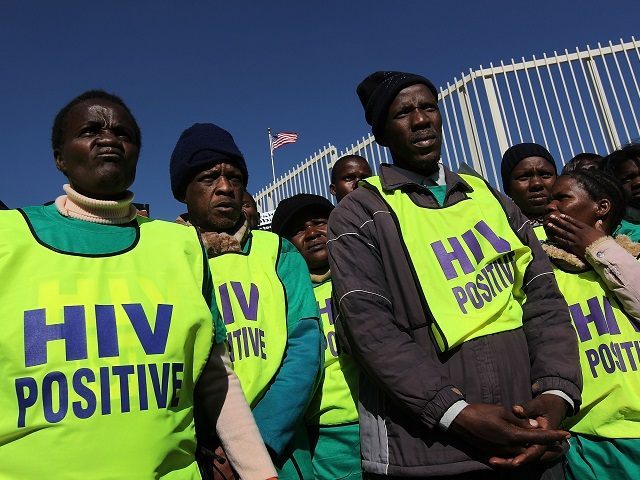There is a cure for AIDS. I know, this claim sounds crazy – but its been tested, and, at least on a small scale experimental level, it appears to work. The principle is sound.
So why doesn’t everyone know about it?
The reason is probably that no government can afford to offer it to the general public, and maybe it sounds too good to be true. The cure is expensive, dangerous for the patient, and requires expensive, intensive medical care, for an extended period.
The story of the cure starts with a little known fact about HIV / AIDS.
HIV attacks the immune system by tricking its way past the CD4 and CCR5 receptor. Receptors are little gateways on the surface of the body’s cells, used to supply the body’s cells with nutrients, excrete waste, and perform other metabolic functions. Some people, especially people of European descent, have a mutation – they don’t have CCR5 receptors, or they have a mutant, dysfunctional CCR5 receptor.
People with this mutation live completely normal lives. The human body is marvellously redundant, with many backup mechanisms which can compensate, most of the time, for missing cellular components. But people with this mutation are different in one vital respect from the rest of us – they are totally immune to most, if not all forms of HIV / AIDS.
This mutation is especially prevalent in European populations, because the ancestors of modern Europeans survived the onslaught of another lethal pathogen which attacked the body’s immune system via the same receptor. The mutation also provides immunity to the Black Death.
So some people are immune – how does this help people who are infected with HIV – people who are obviously not immune?
The reason this matters is that the immune system, like many other human organs, can be transplanted.
White blood cells of the immune system are produced by bone marrow. Bone marrow transplants are old news – people suffering from Leukaemia, cancer of the blood, have been receiving bone marrow transplants for decades, from compatible donors, to replace their own cancerous cells.
The HIV immunity mutation is a very minor genetic difference – it is entirely possible for a HIV immune donor to be genetically compatible with a HIV patient. If the HIV immune donor provides their mutant immune system to a HIV patient, the HIV patient receives the donor’s immunity to AIDS – their new immune system sweeps the HIV virus from their system.
This has been tested on a small scale. The results are encouraging. There is some controversy over the experimental protocol, with some critics claiming that maybe the subject of the experiment never had HIV in the first place. However, this has got to be one of the most promising attempts to find a permanent cure ever described in scientific literature.
“In summary, our results demonstrate successful CD4+ T-cell reconstitution at the systemic level as well as in the largest immunologic organ after CCR5Δ32/Δ32 SCT and in addition provide evidence for the reduction in the size of the potential HIV reservoir over time.
“Although the recovered CD4+ T cells are susceptible to infection with X4 HIV, the patient remains without any evidence of HIV infection for more than 3.5 years after discontinuation of ART. From these results, it is reasonable to conclude that cure of HIV infection has been achieved in this patient”.
There is a complication which makes this procedure particularly dangerous and difficult for HIV / AIDS patients. The first step of performing a bone marrow transplant involves destroying what is left of the patient’s immune system, with powerful toxins, or massive doses of radiation.
Normally this is done in an isolation room, to minimise the patient’s exposure to pathogens. While the new bone marrow is establishing itself, a process which takes a minimum of several weeks, the patient has no resistance to infection. But HIV patients, particularly patients with full blown AIDS, are normally already suffering from multiple serious infections – destroying what is left of their immune system is potentially an extremely high risk procedure.
The subjects of this procedure would require intensive medical treatment during the many weeks in which their new immune system was establishing itself, to stop them from dying, from whatever secondary infections were killing them before the treatment was started.
But for some patients this high risk procedure might be their only hope of life. HIV patients, even patients who take all their medicine, are always living on a knife edge. HIV has a very high mutation rate. Patients who don’t rigorously stick to their treatment protocol, or who are just plain unlucky, can develop a drug resistant form of HIV, which undermines the effectiveness of their anti-viral drugs – eventually causing their HIV / AIDS infection to become untreatable via conventional medicine.
If only there was a way to make the patient’s own cells HIV immune, without the complex dangerous bone marrow transplant procedure. Of course, there might be a way of doing this, at least in theory. The DNA code for at least some versions of the HIV immunity mutation is fairly well known. In principle a patient’s own immune system could be genetically modified, ever so slightly, to give their body the ability to reject HIV, just like people who are naturally immune.
But developing such a treatment would require a great deal of intensive research. There appears to be no real interest in conducting such research. Western governments are far too busy wasting vast sums of money on utter nonsense like combatting climate change, creating failed states in the Middle East, and building economically pointless high speed rail systems.

COMMENTS
Please let us know if you're having issues with commenting.